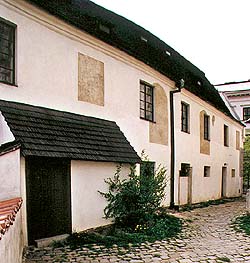Kostelní No. 161
Description of the Building:
The main front with one window axis is situated in a buttress,
which on the ground floor conically widens with a keel. In the side
front are open Gothic window arches. The back elevation is of
early-Rennaissance origin and creates a part of a high buttress,
originally a bastion. The layout of the building is not remarkable
and contains sections with flat ceilings. The cellars are not
accessible.
Architectural and Historical Development:
The building is of Gothic origin, a former chapel, and was built on
the site of the former town fortification, which has been preserved
in the back elevation of the building. That happened during the
reign of Peter I. von
Rosenberg. In 1544 the building underwent a reconstruction. At
that time the house gained its present outer look. In 1623 the
construction of the chapel was improved, and according to the
archival resources, the present roof truss was probably made. After
discontinuation of the chapel in 1784 the homogenous space was
divided with ceilings and the upper floor was created, where flats
were built. At the end of the 19th century the northern front was
renovated in its present appearance.
 Significant
Architectural Features:
Significant
Architectural Features:
A Gothic portal on the ground floor, open Gothic windows in the
side front.
History of the House Residents:
From written resources we learn that Peter Wok von Rosenberg, who
died in 1347, founded the Chapel of St. Václav. This chapel was
soon, in the 14th century, consecrated in the Chapel of St. Jeroným
and was assigned to German inhabitants of Český Krumlov - services
were held by a German priest, who is first mentioned there in 1375.
In 1617 the chapel should have been obtained by the Krumlov
Utraquists, but the chancellor of the Jesuit College destroyed this
intention although the chapel had been whitewashed and decorated.
After the defeat at White Mountain the devastated chapel was given
to a German fraternity of Assumption of Virgin Mary, which built it
up again. The fraternity was abolished in 1784 by the Emperor
Joseph II and the chapel lost its purpose. Two years later it was
bought in auction for 200 guldens by a royal construction director
Antonín Reising von Reisinger who rebuilt it into a habitable
house. In 1819 it was inherited by his daughter Eufrosina, married
Ebenhöch. In 1858 the administrator of church manors of Vyšší Brod
František Špatný sold the house to Krumlov magistrate for the
establishment of a working school for girls and boys. Later on a
German music school was situated there and from 1947 a Czech music
school.
 Present
Use:
Present
Use:
There is Elementary
Art School in the building.


